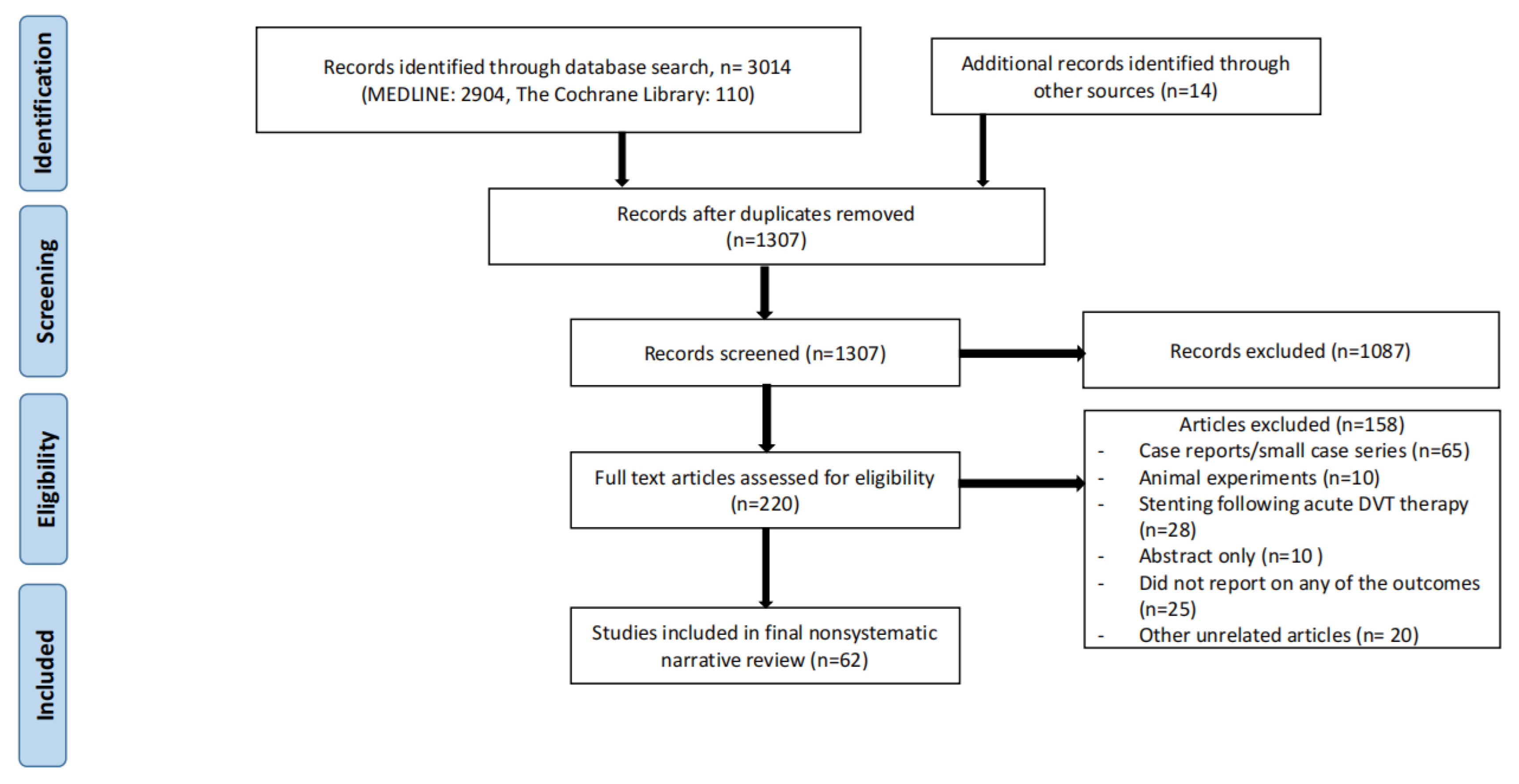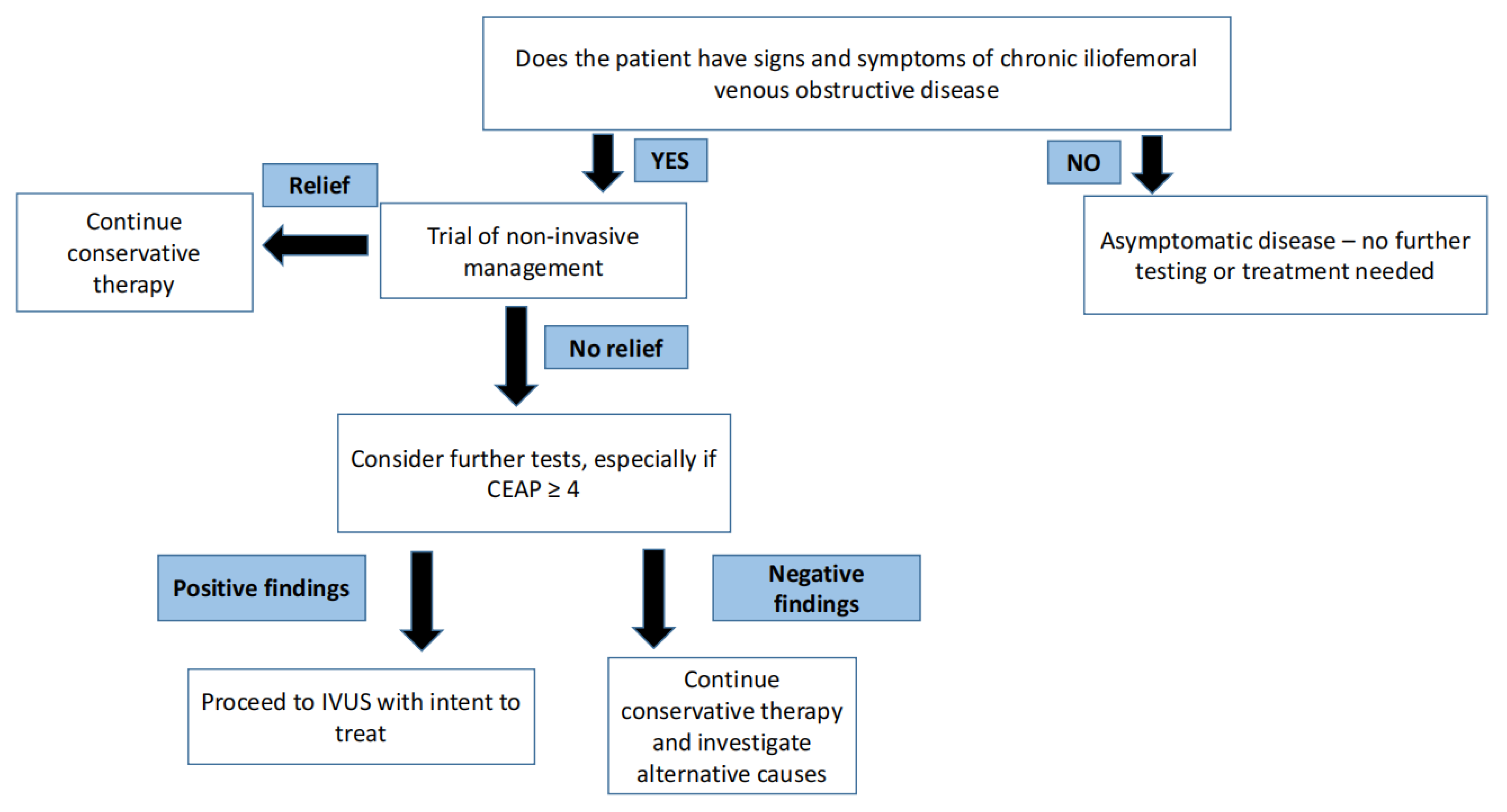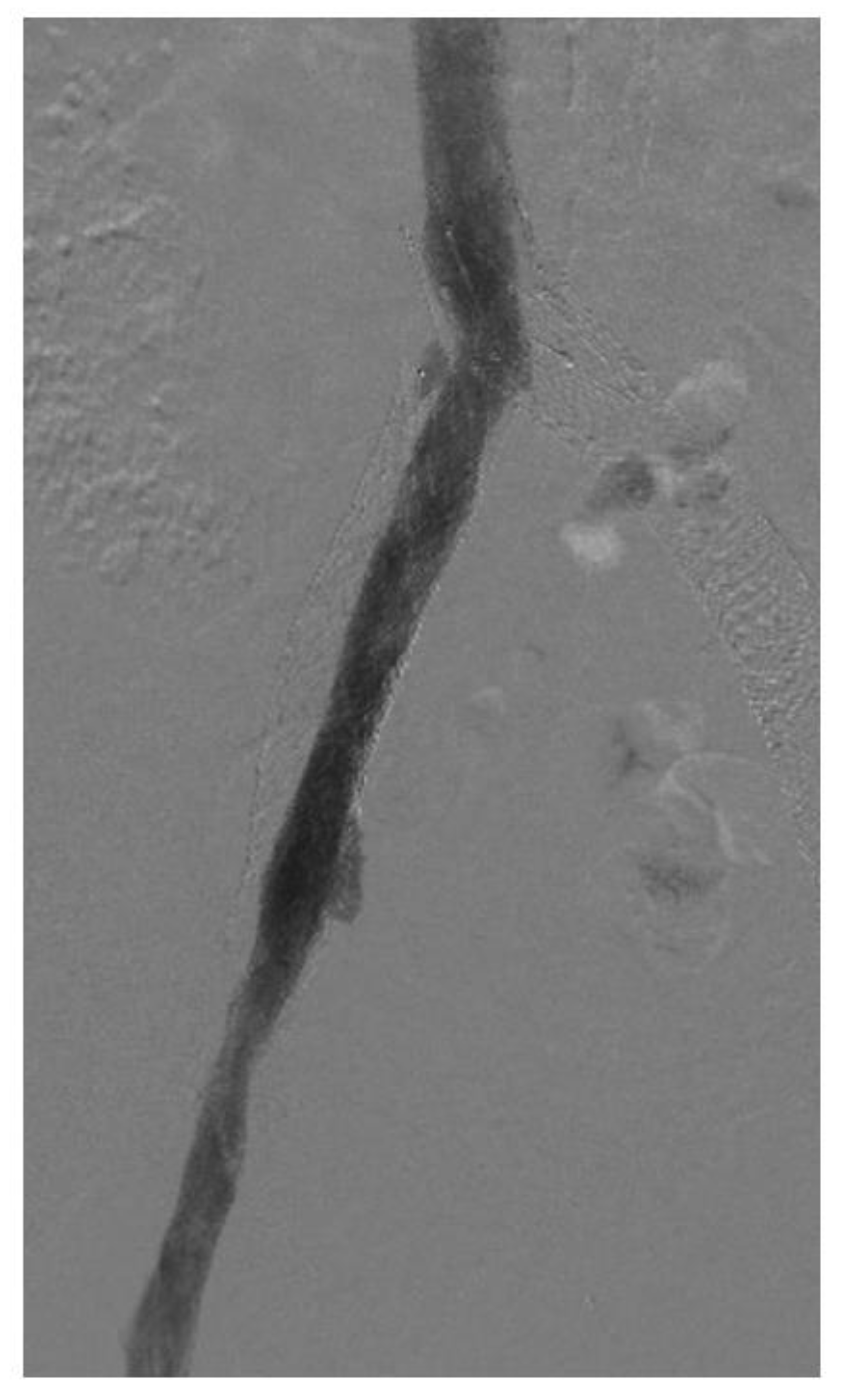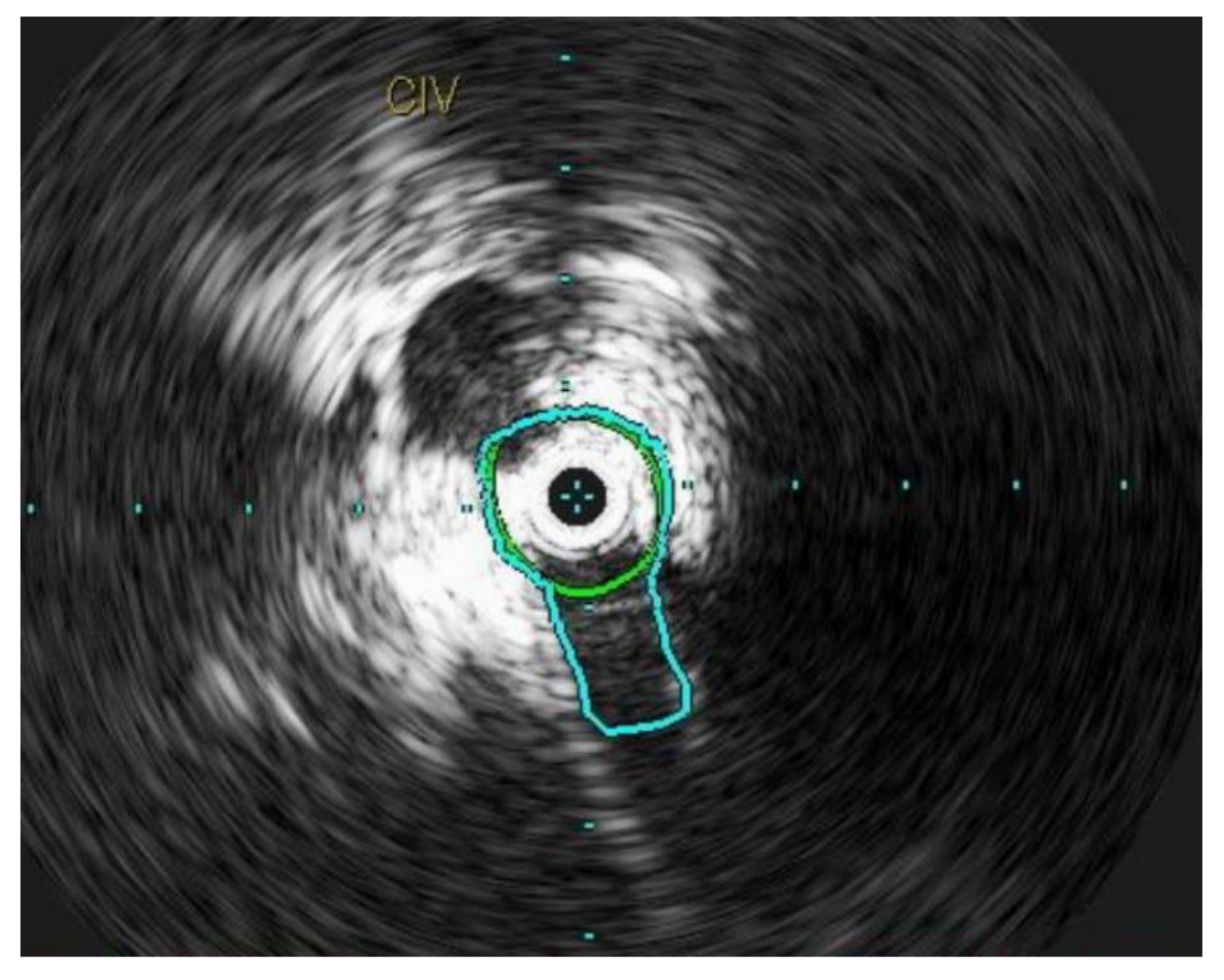An Overview of Specific Considerations in Chronic Venous Disease and Iliofemoral Venous Stenting
Abstract
1. Introduction
2. Materials and Methods
3. Results
3.1. Phases of Endovenous Stenting
3.2. Philosophy of Treating CVD
3.3. Elderly Population
3.4. Socioeconomic Factors
3.5. Other Indications for Treatment
3.6. Graduated Compression Stockings
3.7. Thrombophilia Panel
- When a risk of recurrent thrombosis can be identified via thrombophilia testing.
- When the management of asymptomatic family members who are carriers of the condition is impacted.
- Patient preference because he/she would like to better understand the etiology of the thrombotic event.
- When the risk of VTE recurrence is intermediate and obtaining the thrombophilia panel will help in decision making about long term anticoagulation [21].
3.8. Stenting across Inguinal Ligament
3.9. Intravascular Ultrasound
3.10. In-Stent Restenosis
3.11. Adequate Sizing of Venous Stents
3.12. Anticoagulation and Antiplatelet Regimens
3.13. Diabetes and Venous Stenting
3.14. May-Thurner Syndrome and Compressive Iliac Vein Lesions
3.15. Various Types of Venous Stents
3.16. Iliac Vein Stenting without Venography (Dyeless Iliac Vein Stenting)
3.17. Extension of the Iliac Vein Stent into the Profunda Vein
3.18. Effect of Iliac Vein Stenting on Reflux
4. Discussion
4.1. Types of Lesions
4.2. Patient Selection and Criteria for Stenting
4.3. Other Special Groups of Patients/Miscellaneous Considerations
4.3.1. Central Neuromuscular Disorders
4.3.2. Klippel-Trenaunay Syndrome
4.3.3. Obese Patients
4.3.4. Pregnancy
4.3.5. Post-Menopausal Patients
4.3.6. Patients with Femoral Vein Occlusion
4.3.7. Bilateral Iliac Vein Stenting
5. Limitations
6. Conclusions
Funding
Institutional Review Board Statement
Informed Consent Statement
Conflicts of Interest
Abbreviations
References
- Davies, A.H. The seriousness of chronic venous disease: A review of real-world evidence. Adv Ther. 2019, 36 (Suppl. 1), 5–12. [Google Scholar] [CrossRef] [PubMed]
- Saleem, T. Bridging the divide between the surgeon and the interventional radiologist: Cooperation or/and competition? Langenbecks Arch. Surg. 2009, 394, 971. [Google Scholar] [CrossRef] [PubMed]
- Lurie, F.; Passman, M.; Meisner, M.; Dalsing, M.; Masuda, E.; Welch, H.; Bush, R.L.; Blebea, J.; Carpentier, P.H.; De Maeseneer, M.; et al. The 2020 update of the CEAP classification system and reporting standards. J. Vasc. Surg. Venous Lymphat. Disord. 2020, 8, 342–352. [Google Scholar] [CrossRef]
- Archie, M.M.; Rollo, J.C.; Gelabert, H.A. Surgical missteps in the management of venous thoracic outlet syndrome which lead to reoperation. Ann. Vasc. Surg. 2018, 49, 261–267. [Google Scholar] [CrossRef] [PubMed]
- Saleem, T.; Barry, O.; Thaggard, D.; Peeples, H.; Raju, S. Iliac vein stent failure in community practice and results of corrective interventions. J. Vasc. Surg. Venous Lymphat. Disord. 2023, S2213-333X(22)00506-6. [Google Scholar] [CrossRef]
- Raju, S.; Ward, M. Utility of iliac vein stenting in elderly population older than 80 years. J. Vasc. Surg. Venous Lymphat. Disord. 2015, 3, 58–63. [Google Scholar] [CrossRef] [PubMed]
- Raju, S.; Tackett, P.; Neglen, P. Spontaneous onset of bacterial cellulitis in lower limbs with chronic obstructive venous disease. Eur. J. Vasc. Endovasc. Surg. 2008, 36, 606–610. [Google Scholar] [CrossRef]
- Kibrik, P.; Eisenberg, J.; Alsheekh, A.; Rizvi, S.A.; Aurshina, A.; Marks, N.; Hingorani, A.; Ascher, E. Safety and efficacy of stenting nonthrombotic iliac vein lesions in octogenarians and nonagenarians in an office setting. Vascular 2018, 26, 70–74. [Google Scholar] [CrossRef]
- Saleem, T.; Powell, T.; Raju, S. Iliofemoral venous stenting in patients with central neuromuscular disorders. J. Vasc. Surg. Venous Lymphat. Disord. 2022, 10, 626–632. [Google Scholar] [CrossRef]
- Saleem, T.; Lucas, M.; Thaggard, D.; Peeples, H.; Luke, C.; Raju, S. Clinical tolerance of untreated reflux after iliac vein stent placement. J. Vasc. Surg. Venous Lymphat. Disord. 2022, in press. [CrossRef]
- Saleem, T.; Luke, C.; Raju, S. Options in the treatment of superficial and deep venous disease in patients with Klippel-Trenaunay syndrome. J. Vasc. Surg. Venous Lymphat. Disord. 2022, 10, 1343–1351.e3. [Google Scholar] [CrossRef] [PubMed]
- Saleem, T.; Burr, B.; Robinson, J.; Degelman, K.; Stokes, J.; Noel, C.; Fuller, R. Elevated plasma factor VIII levels in a mixed patient population on anticoagulation and past venous thrombosis. J. Vasc. Surg. Venous Lymphat. Disord. 2021, 9, 1119–1127. [Google Scholar] [CrossRef] [PubMed]
- Raju, S.; Lurie, F.; O’Donnell, T.F., Jr. Compression use in the era of endovenous interventions and wound care centers. J. Vasc. Surg. Venous Lymphat. Disord. 2016, 4, 346–354. [Google Scholar] [CrossRef]
- Benigni, J.P.; Sadoun, S.; Allaert, F.A.; Vin, F. Efficacy of class 1 elastic compression stockings in the early stages of chronic venous disease. A comparative study. Int. Angiol. 2003, 22, 383–392. [Google Scholar] [PubMed]
- Jayaraj, A.; Meissner, M. Impact of graduated compression stockings on the prevention of post-thrombotic syndrome–results of a randomized controlled trial. Phlebology 2015, 30, 541–548. [Google Scholar] [CrossRef] [PubMed]
- Knight Nee Shingler, S.L.; Robertson, L.; Stewart, M. Graduated compression stockings for the intial treatment of varicose veins in people without venous ulceration. Cochrane Database Syst. Rev. 2021, 7, CD008819. [Google Scholar]
- O’Meara, S.; Cullum, N.; Nelson, E.A.; Dumville, J.C. Compression for venous leg ulcers. Cochrane Database Syst. Rev. 2012, 11, CD000265. [Google Scholar] [CrossRef]
- Lawrence, P.F.; Hager, E.S.; Harlander-Locke, M.P.; Pace, N.; Jayaraj, A.; Yohann, A.; Kalbaugh, C.; Marston, W.; Kabnick, L.; Saqib, N.; et al. Treatment of superficial and perforator reflux and deep venous stenosis improves healing of chronic venous leg ulcers. J. Vasc. Surg. Venous Lymphat. Disord. 2020, 8, 601–609. [Google Scholar] [CrossRef]
- Ziaja, D.; Kocełak, P.; Chudek, J.; Ziaja, K. Compliance with compression stockings in patients with chronic venous disorders. Phlebology 2011, 26, 353–360. [Google Scholar] [CrossRef]
- Raju, S.; Hollis, K.; Neglen, P. Use of compression stockings in chronic venous disease: Patient compliance and efficacy. Ann. Vasc. Surg. 2007, 21, 790–795. [Google Scholar] [CrossRef]
- Moll, S. Thrombophilia: Clinical-practical aspects. J. Thromb. Thrombolysis 2015, 39, 367–378. [Google Scholar] [CrossRef]
- Saleem, T. The stent’s gatekeeper: Inflow disease. Eur. J. Vasc. Endovasc. Surg. 2022, 64, 738–739. [Google Scholar] [CrossRef] [PubMed]
- Neglén, P.; Tackett, T.P., Jr.; Raju, S. Venous stenting across the inguinal ligament. J. Vasc. Surg. 2008, 48, 1255–1261. [Google Scholar] [CrossRef]
- Murphy, E.; Gibson, K.; Sapoval, M.; Dexter, D.J.; Kolluri, R.; Razavi, M.; Black, S. Pivotal study evaluating the safety and effectiveness of the abre venous self-expanding stent system in patients with symptomatic iliofemoral venous outflow obstruction. Circ. Cardiovasc. Interv. 2022, 15, e010960. [Google Scholar] [CrossRef]
- Black, S.; Gwozdz, A.; Karunanithy, N.; Silickas, J.; Breen, K.; Hunt, B.; Smith, A.; Cohen, A.; Saha, P. Two year outcome after chronic iliac vein occlusion recanalisation using the Vici venous stent. Eur. J. Vasc. Endovasc. Surg. 2018, 56, 710–718. [Google Scholar] [CrossRef] [PubMed]
- Dake, M.D.; O’Sullivan, G.; Shammas, N.W.; Lichtenberg, M.; Mwipatayi, B.P.; Settlage, R.A. VERNACULAR Trial Investigators. Three-year results from the Venovo venous stent study for the treatment of iliac and femoral vein obstruction. Cardiovasc. Interv. Radiol. 2021, 44, 1918–1929. [Google Scholar] [CrossRef] [PubMed]
- O’Sullivan, G.J.; Karunanithy, N.; Binkert, C.A.; Ortega, M.R.; Lichtenberg, M.; McCann-Brown, J.A. One year outcomes of the VIVO-EU study of treatment of symptomatic iliofemoral outflow obstruction with the Zilver Vena venous self-expending stent. Cardiovasc. Interv. Radiol. 2021, 44, 1930–1936. [Google Scholar] [CrossRef]
- Saleem, T.; Knight, A.; Raju, S. Diagnostic yield of intravascular ultrasound in patients with clinical signs and symptoms of lower extremity venous disease. J. Vasc. Surg. Venous Lymphat. Disord. 2020, 8, 634–639. [Google Scholar] [CrossRef] [PubMed]
- Saleem, T. Accurate and appropriate selection of patients for endovenous iliofemoral intervention: Are we there yet? Eur. J. Vasc. Endovasc. Surg. 2022, 64, 135–136. [Google Scholar] [CrossRef]
- Saleem, T.; Raju, S. Comparison of intravascular ultrasound and multidimensional contrast imaging modalities for characterization of chronic occlusive iliofemoral venous disease: A systematic review. J. Vasc. Surg. Venous Lymphat. Disord. 2021, 9, 1545–1556.e2. [Google Scholar] [CrossRef] [PubMed]
- Montminy, M.L.; Thomasson, J.D.; Tanaka, G.J.; Lamanilao, L.M.; Crim, W.; Raju, S. A comparison between intravascular ultrasound and venography in identifying key parameters essential for iliac vein stenting. J. Vasc. Surg. Venous Lymphat. Disord. 2019, 7, 801–807. [Google Scholar] [CrossRef]
- Saleem, T.; Raju, S. An overview of in-stent restenosis in iliofemoral venous stents. J. Vasc. Surg. Venous Lymphat. Disord. 2022, 10, 492–503.e2. [Google Scholar] [CrossRef] [PubMed]
- Saleem, T. In-stent restenosis and stent compression in iliofemoral venous stents. Quant. Imaging Med. Surg. 2022, 12, 1658–1659. [Google Scholar] [CrossRef] [PubMed]
- Raju, S. Ten lessons learned in iliac venous stenting. Endovasc Today 2016, 15, 40–44. [Google Scholar]
- Kassab, G.; Raju, S. Grading venous stenosis is different from arterial lesions. J. Vasc. Surg. Venous Lymphat. Disord. 2019, 7, 151–152. [Google Scholar] [CrossRef]
- Endo, M.; Jahangiri, Y.; Horikawa, M.; Kaufman, J.A.; Schenning, R.C.; Kolbeck, K.J.; Barton, R.E.; Ohuchi, Y.; Liang, K.W.; Farsad, K. Antiplatelet therapy is associated with stent patency after iliocaval venous stenting. Cardiovasc. Interv. Radiol. 2018, 41, 1691–1698. [Google Scholar] [CrossRef]
- Hays, K.; Jolly, M.; Silver, M.; Phillips, J.; Huff, C.; Secic, M.; Ansel, G.; Kolluri, R. Outcomes of endovascular venous stenting in patients on direct oral anticoagulants and antiplatelet therapy at a tertiary referral center. J. Vasc. Surg. Venous Lymphat. Disord. 2021, 9, 753–759.e1. [Google Scholar] [CrossRef]
- Milinis, K.; Thapar, A.; Shalhoub, J.; Davies, A.H. Antithrombotic therapy following venous stenting; International Delphi Consensus. Eur. J. Vasc. Endovasc. Surg. 2018, 55, 537–544. [Google Scholar] [CrossRef]
- Veyg, D.; Alam, M.; Yelkin, H.; Dovlatyan, R.; DiBenedetto, L.; Ting, W. A systematic review of current trends in pharmacologic management after stent placement in nonthrombotic iliac vein lesions. Phlebology 2022, 37, 157–164. [Google Scholar] [CrossRef]
- Lin, C.; Martin, K.A.; Wang, M.; Stein, B.L.; Desai, K.R. Long-term antithrombotic therapy after venous stent placement. Phlebology 2020, 35, 402–408. [Google Scholar] [CrossRef]
- Chung, W.S.; Lin, C.L.; Kao, C.H. Diabetes increases the risk of deep-vein thrombosis and pulmonary embolism. A population-based cohort study. Thromb. Haemost. 2015, 114, 812–818. [Google Scholar] [CrossRef] [PubMed]
- Petrauskiene, V.; Falk, M.; Waernbaum, I.; Norberg, M.; Eriksson, J.W. The risk of venous thromboembolism is markedly elevated in patients with diabetes. Diabetologia 2005, 48, 1017–1021. [Google Scholar] [CrossRef]
- Matic, P.; Jolic, S.; Tanaskovic, S.; Soldatovic, I.; Katsiki, N.; Isenovic, E.; Radak, D. Chronic venous disease and comorbidities. Angiology 2015, 66, 539–544. [Google Scholar] [CrossRef] [PubMed]
- Achim, A.; Stanek, A.; Homorodean, C.; Spinu, M.; Onea, H.L.; Lazăr, L.; Marc, M.; Ruzsa, Z.; Olinic, D.M. Approaches to peripheral artery disease in diabetes: Are there any differences? Int. J. Environ. Res. Public Health 2022, 19, 9801. [Google Scholar] [CrossRef] [PubMed]
- Achim, A.; Lackó, D.; Hüttl, A.; Csobay-Novák, C.; Csavajda, Á.; Sótonyi, P.; Merkely, B.; Nemes, B.; Ruzsa, Z. Impact of diabetes mellitus on early clinical outcome and stent restenosis after carotid artery stenting. J. Diabetes Res. 2022, 2022, 4196195. [Google Scholar] [CrossRef]
- Kibbe, M.R.; Ujiki, M.; Goodwin, A.L.; Eskandari, M.; Yao, J.; Matsumura, J. Iliac vein compression in an asymptomatic patient population. J. Vasc. Surg. 2004, 39, 937–943. [Google Scholar] [CrossRef]
- Raju, S.; Neglen, P. High prevalence of nonthrombotic iliac vein lesions in chronic venous disease: A permissive role in pathogenicity. J. Vasc. Surg. 2006, 44, 136–143; discussion 144; [Google Scholar] [CrossRef]
- Fereydooni, A.; Stern, J.R. Contemporary treatment of May-Thurner syndrome. J. Cardiovasc. Surg. (Torino) 2021, 62, 447–455. [Google Scholar] [CrossRef]
- Kaltenmeier, C.T.; Erben, Y.; Indes, J.; Lee, A.; Dardik, A.; Sarac, T.; Chaar, C.I.O. Systematic review of May-Thurner syndrome with emphasis on gender differences. J. Vasc. Surg. Venous Lymphat. Disord. 2018, 6, 399–407.e4. [Google Scholar] [CrossRef]
- Seager, M.J.; Busuttil, A.; Dharmarajah, B.; Davies, A.H. Editor’s choice–a systematic review of endovenous stenting in chronic venous disease secondary to iliac vein obstruction. Eur. J. Vasc. Endovasc. Surg. 2016, 51, 100–120. [Google Scholar] [CrossRef]
- Murphy, E. Surveying the 2019 venous stent landscape. Endovasc Today 2019, 18, 53–64. [Google Scholar]
- Murphy, E. Venous stenting: A behind-the-scenes look at the trial data. Endovasc Today 2022, 21, 37–42. [Google Scholar]
- Raju, S.; Luke, C.; Powell, T.; Saleem, T.; Jayaraj, A. Extension of iliac vein stent into the profunda femoral vein for salvage. J. Vasc. Surg. Venous Lymphat. Disord. 2022, 10, 1059–1065.e1. [Google Scholar] [CrossRef] [PubMed]
- Saleem, T. Re: Clinical outcomes and overview of dedicated venous stents for management of chronic iliocaval and femoral deep venous disease. Vascular 2022, 17085381221097306. [Google Scholar] [CrossRef]
- Saleem, T. Re: Comparison of anticoagulation regimens following stent placement for nonthrombotic lower extremity venous disease. J. Vasc. Interv. Radiol. 2022, 33, 341. [Google Scholar] [CrossRef]
- Saleem, T. Evolution of dedicated stents for deep venous revascularization–marching forward with cautious optimism. Phlebology 2022, 37, 149–150. [Google Scholar] [CrossRef]
- Jayaraj, A.; Raju, S. Clinical improvement after stenting for chronic iliofemoral venous obstruction: A review of large studies. Vasc. Investig. Ther. 2022, 5, 22–27. [Google Scholar]
- Saleem, T. Clinical improvement after iliac vein stenting stratified by CEAP class. Ann. Vasc. Surg. 2022, 86, e3. [Google Scholar] [CrossRef] [PubMed]
- Padberg, F., Jr.; Cerveira, J.J.; Lal, B.K.; Pappas, P.J.; Varma, S.; Hobson, R.W., 2nd. Does severe venous insufficiency have a different etiology in the morbidly obese? Is it venous? J. Vasc. Surg. 2003, 37, 79–85. [Google Scholar] [CrossRef]
- Jayaraj, A.; Powell, T.; Raju, S. Effect of body mass index on initial presentation and outcomes after stenting for quality of life-impairing chronic iliofemoral venous obstruction. J. Vasc. Surg. Venous Lymphat. Disord. 2022, 10, 325–333.e1. [Google Scholar] [CrossRef]
- Raju, S.; Darcey, R.; Neglen, P. Iliac-caval stenting in the obese. J. Vasc. Surg. 2009, 50, 1114–1120. [Google Scholar] [CrossRef] [PubMed]
- Dasari, M.; Avgerinos, E.; Raju, S.; Tahara, R.; Chaer, R.A. Outcomes of iliac vein stents after pregnancy. J. Vasc. Surg. Venous Lymphat. Disord. 2017, 5, 353–357. [Google Scholar] [CrossRef] [PubMed]
- Pappas, P.J.; Lakhanpal, G.; Soto, T.; Deol, Z.; Kennedy, R.; Lakhanpal, S. Pregnancy after iliac vein stenting for pelvic venous insufficiency. J. Vasc. Surg. Venous Lymphat. Disord. 2022, 10, 342–347. [Google Scholar] [CrossRef] [PubMed]
- Raju, S.; Oglesbee, M.; Neglén, P. Iliac vein stenting in postmenopausal leg swelling. J. Vasc. Surg. 2011, 53, 123–130. [Google Scholar] [CrossRef]
- Raju, S.; Ward, M., Jr.; Davis, M. Relative importance of iliac vein obstruction in patients with post-thrombotic femoral vein occlusion. J. Vasc. Surg. Venous Lymphat. Disord. 2015, 3, 161–167. [Google Scholar] [CrossRef]
- Raju, S.; Fountain, T.; Neglén, P.; Devidas, M. Axial transformation of the profunda femoris vein. J. Vasc. Surg. 1998, 27, 651–659. [Google Scholar] [CrossRef]
- Neglén, P.; Darcey, R.; Olivier, J.; Raju, S. Bilateral stenting at the iliocaval confluence. J. Vasc. Surg. 2010, 51, 1457–1466. [Google Scholar] [CrossRef]
- Jayaraj, A.; Noel, C.; Raju, S. Contralateral limb improvement after unilateral iliac vein stenting argues against simultaneous bilateral stenting. J. Vasc. Surg. Venous Lymphat. Disord. 2020, 8, 565–571. [Google Scholar] [CrossRef]





| C (Clinical), E (Etiology), A (Anatomic), P (Pathophysiological) | |
|---|---|
| C0 | No visible or palpable signs of venous disease |
| C1 | Telangiectasias or reticular veins |
| C2 | Varicose veins |
| C2r | Recurrent varicose veins |
| C3 | Edema |
| C4 | Changes in skin and subcutaneous tissue secondary to chronic venous disease |
| C4a | Pigmentation or eczema |
| C4b | Lipodermatosclerosis or atrophie blanche |
| C4c | Corona phlebectatica |
| C5 | Healed ulcer |
| C6 | Active venous ulcer |
| C6r | Recurrent active venous ulcer |
| Type of Stent | Company | FDA Approval | Stent Design | Delivery System |
|---|---|---|---|---|
| Wallstent | Boston Scientific Corporation | 2020 | Braided | Coaxial |
| Abre | Medtronic | 2020 | Open cell | Triaxial |
| Venovo | BD Interventional | 2019 | Open cell | Triaxial |
| VICI | Boston Scientific Corporation | 2019 | Closed cell | Coaxial |
| Zilver Vena | Cook Medical | 2020 | Open cell | Coaxial |
| Type of Stent | Trial | Patients (N) | Patency |
|---|---|---|---|
| Wallstent | No formal clinical trial; plethora of data available from large retrospective case series | - | Primary (5-year): 67% Primary-assisted (5-year): 89% Secondary (5-year): 93% |
| Abre | ABRE | 200 | Primary (2-years): 86.2% |
| Venovo | VERNACULAR | 170 | Primary (3-years): 79.5% |
| VICI | VIRTUS | 200 | Primary (3-years): 71.7% |
| Zilver Vena | VIVO | 243 | Primary (3-years): 90.3% |
Disclaimer/Publisher’s Note: The statements, opinions and data contained in all publications are solely those of the individual author(s) and contributor(s) and not of MDPI and/or the editor(s). MDPI and/or the editor(s) disclaim responsibility for any injury to people or property resulting from any ideas, methods, instructions or products referred to in the content. |
© 2023 by the author. Licensee MDPI, Basel, Switzerland. This article is an open access article distributed under the terms and conditions of the Creative Commons Attribution (CC BY) license (https://creativecommons.org/licenses/by/4.0/).
Share and Cite
Saleem, T. An Overview of Specific Considerations in Chronic Venous Disease and Iliofemoral Venous Stenting. J. Pers. Med. 2023, 13, 331. https://doi.org/10.3390/jpm13020331
Saleem T. An Overview of Specific Considerations in Chronic Venous Disease and Iliofemoral Venous Stenting. Journal of Personalized Medicine. 2023; 13(2):331. https://doi.org/10.3390/jpm13020331
Chicago/Turabian StyleSaleem, Taimur. 2023. "An Overview of Specific Considerations in Chronic Venous Disease and Iliofemoral Venous Stenting" Journal of Personalized Medicine 13, no. 2: 331. https://doi.org/10.3390/jpm13020331
APA StyleSaleem, T. (2023). An Overview of Specific Considerations in Chronic Venous Disease and Iliofemoral Venous Stenting. Journal of Personalized Medicine, 13(2), 331. https://doi.org/10.3390/jpm13020331





